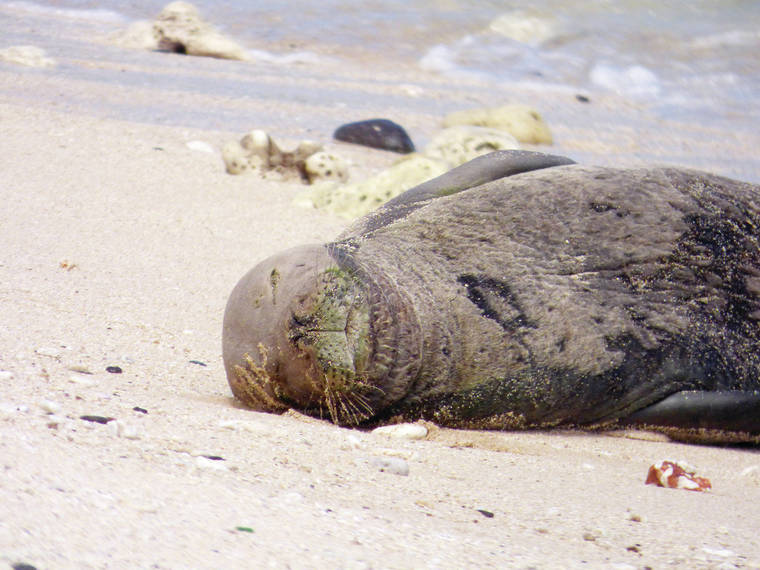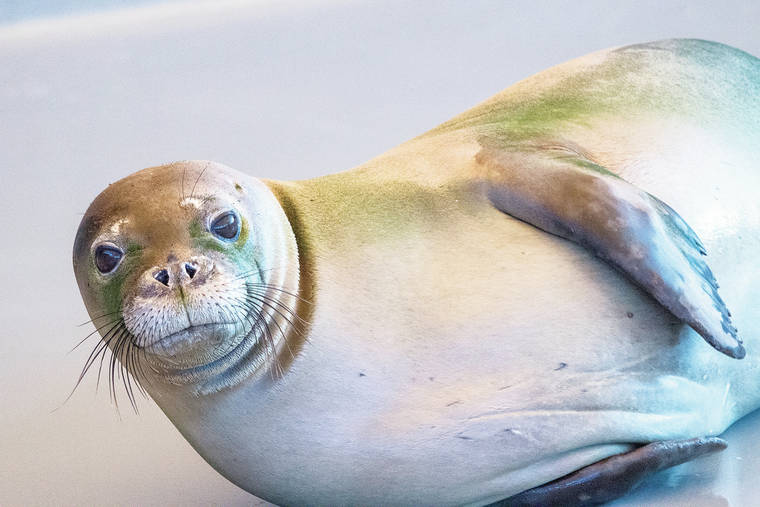HA‘ENA — An adult female Hawaiian monk seal has been found dead on Ha‘ena Beach in Kaua‘i, reported to officials Saturday, April 25, the same day the well-known monk seal Honey Girl’s body was removed from a windward beach on O‘ahu.
HA‘ENA — An adult female Hawaiian monk seal has been found dead on Ha‘ena Beach in Kaua‘i, reported to officials Saturday, April 25, the same day the well-known monk seal Honey Girl’s body was removed from a windward beach on O‘ahu.
National Oceanic and Atmospheric Administration Fisheries confirmed the report Monday and said the seal is R313. NOAA Fisheries didn’t have any more information about the seal’s death on Monday but a spokesperson said more info should be forthcoming throughout the week.
According to Kaua‘i monk seal volunteers, who monitor condition and activity of the seals that haul out on Kaua‘i beaches, R313 was easily identifiable by pit scars on the left and right sides, as well as a line scars on her body. Kaua‘i volunteers reported seeing the seal — alive, active and freshly molted — on Kaua‘i in January. She was known to pup on Kaua‘i beaches.
There is currently no obvious connection between the deaths of Honey Girl on O‘ahu and R313 on Kaua‘i.
The seal was well-known on Kaua‘i and never had to make a trip to Ke Kai Ola, the monk seal hospital at The Marine Mammal Center on Hawaii Island. Since 2014, the hospital has treated only two seals that were picked up and released on Kaua‘i Beaches: RK50 and RH38.
Seal RH38 made that visit twice — once in 2017 and then again in 2019. She was the first Hawaiian monk seal ever to receive a CT scan and was treated for severe malnutrition and a heavy parasite load.
Parasites and malnutrition are just a couple of the challenges this endangered species faces. Other threats include habitat loss and entanglement in nets and marine debris, food limitations and interactions with humans intending harm and fisheries. Disease is also a threat to the Hawaiian monk seal population including viruses like West Nile virus, leptospirosis, and toxoplasmosis, according to NOAA Fisheries. Other threats include shark predation and male monk seal aggression.
The body of monk seal R313 is currently roped off and NOAA Fisheries is responding to remove it from the beach. More information will be reported as it is released.
The public is reminded to keep a safe distance from all marine wildlife and to report sightings of sick or injured marine mammals and sea turtles to 888-256-9840.
•••
Jessica Else, editor-in-chief, can be reached at 245-0457 or jelse@thegardenisland.com.







Did the feral cats kill another seal?
Wanna big up Kauai Community Cat project for all their hard work feeding feral cats and keeping toxoplasmosis alive and well! Here on Kauai, with some of the rarest species on earth, I think we should work hard to take care of the feral cats, feed them, neuter them, then re-release them to keep feeding on endangered birds and spreading that yummy toxoplasmosis. And now that KHS charges $90 to euthanize a feral cat, they’re bound to increase their population by leaps and bounds. All these monk seals that keep dying? Well that’s gonna keep happening- feral cats come first apparently.
The number ONE cause of death for monk seals is humans. Net entanglement/fisheries by-catch kill more marine mammals than any other cause. And don’t forget there have been at-least 9 documented murders of monk seals (that we know of) — Shameful!